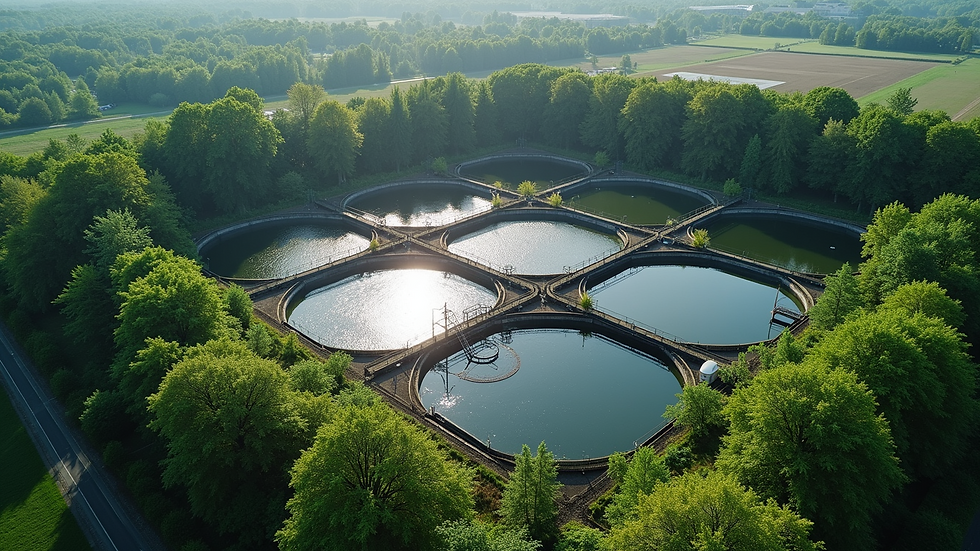Transforming Waste into Wealth: The Hidden Environmental Benefits of Sewage Treatment Plants
- karan9377
- Jun 25
- 3 min read
Updated: Jul 26
Sewage treatment plants (STPs) might not capture the spotlight, but they play a crucial role in making our environment cleaner and safer. These facilities transform wastewater—used water from homes and industries—into a resource. This process offers numerous advantages for both public health and ecological sustainability. Let’s explore the often-overlooked benefits of sewage treatment plants and understand their critical function in our communities.
Understanding Sewage Treatment Plants
At its core, a sewage treatment plant is engineered to cleanse polluted water. This wastewater can contain harmful substances that need to be filtered out to prevent environmental damage. The treatment process typically involves three primary stages: physical, biological, and chemical methods. Together, these methods ensure water is sufficiently purified before being reintroduced into nature.
The urgency for effective wastewater management escalates with growing urban populations. Untreated sewage can wreak havoc on local water sources and ecosystems.
Environmental Protection
Sewage treatment plants significantly protect local ecosystems. For example, untreated sewage can severely harm aquatic life, leading to pollution in rivers and lakes and threatening biodiversity. By treating around 90% of the common pollutants from sewage, STPs mitigate these risks, helping conserve crucial aquatic habitats.
Additionally, effective sewage management blocks toxic substances from entering the food chain. For instance, STPs prevent heavy metals and pathogens from accumulating in fish, protecting both wildlife and human health. According to the World Health Organization, improving water quality could reduce the incidence of waterborne diseases by up to 75%. This showcases the powerful impact of STPs.

Resource Recovery
In an era where sustainability is crucial, sewage treatment plants are becoming vital for resource recovery. Through advanced technologies, STPs convert sewage sludge into valuable products, such as renewable energy and fertilizers.
For example, biogas generated during the anaerobic digestion process can be used for heating or electricity. This reduces reliance on fossil fuels. In cities like San Diego, biogas from STPs has been used to supply around 15% of the total energy needs for the facilities themselves.
Furthermore, the nutrient-rich biosolids can be processed into fertilizers that enrich agricultural soils. This promotes sustainable farming practices while helping divert about 50% of organic waste from landfills.
Water Reuse and Conservation
As global water scarcity increases, STPs serve as vital components in water conservation efforts. They can treat wastewater to a standard suitable for reuse, allowing communities to recycle this precious resource. Reclaimed water can serve many purposes, including irrigation for parks and fields or industrial cooling processes.
In Israel, approximately 86% of wastewater is reused, primarily for agricultural irrigation. This practice meets the needs of a growing population and eases the demand on freshwater resources.

Public Health Improvement
Sewage treatment plants are essential for public health. By adequately treating wastewater, STPs significantly reduce the risk of waterborne diseases caused by contaminants in untreated sewage. For instance, the CDC estimates that proper sewage treatment prevents illness outbreaks such as cholera and dysentery.
In many developing areas, simple improvements in sewage treatment can lead to a 50-75% reduction in disease rates. This showcases how essential these facilities are for community well-being. Their role in promoting public health awareness also emphasizes the importance of waste management.
Economic Advantages
Investing in sewage treatment plants brings notable economic advantages. Not only do these facilities create jobs in construction, operation, and maintenance, but they also enable local industries to meet environmental standards and regulations on wastewater discharge.
Moreover, sustainable wastewater management can increase property values and attract businesses looking for environmentally responsible communities. In cities with effective STPs, property values have seen increases of up to 20%. This demonstrates the economic ripple effects of good sewage management.
Addressing Climate Change
Sewage treatment plants are instrumental in addressing climate change. They help lower emissions from wastewater disposal, which contributes to climate resilience efforts. Innovative technologies, such as nutrient recovery and energy generation, enable STPs to reduce reliance on non-renewable resources.
For instance, according to the EPA, STPs can cut up to 90% of their greenhouse gas emissions through effective management practices. This tackles environmental challenges while catalyzing communities toward more sustainable living.
Embracing Sustainable Water Management
Sewage treatment plants may not shine in the spotlight, but their environmental benefits are substantial. From protecting aquatic ecosystems to improving public health and mitigating climate change, STPs serve multiple purposes that extend beyond traditional waste management.
As we enhance our understanding of their benefits, it is essential for communities to support innovations in sewage treatment technologies and adopt sustainable practices in wastewater management. By viewing waste as a resource rather than a burden, we can transform waste into wealth. This promotes a healthier and more sustainable future for generations to come.
In recognizing the hidden environmental benefits of sewage treatment plants, we set the stage for a future where waste management harmoniously integrates with ecological health, economic prosperity, and social well-being.
Learn more about how sewage treatment plants impact our society and environment.



Comments